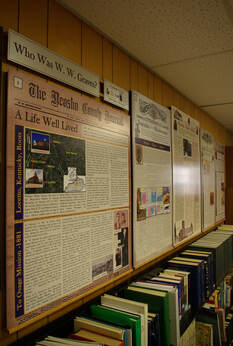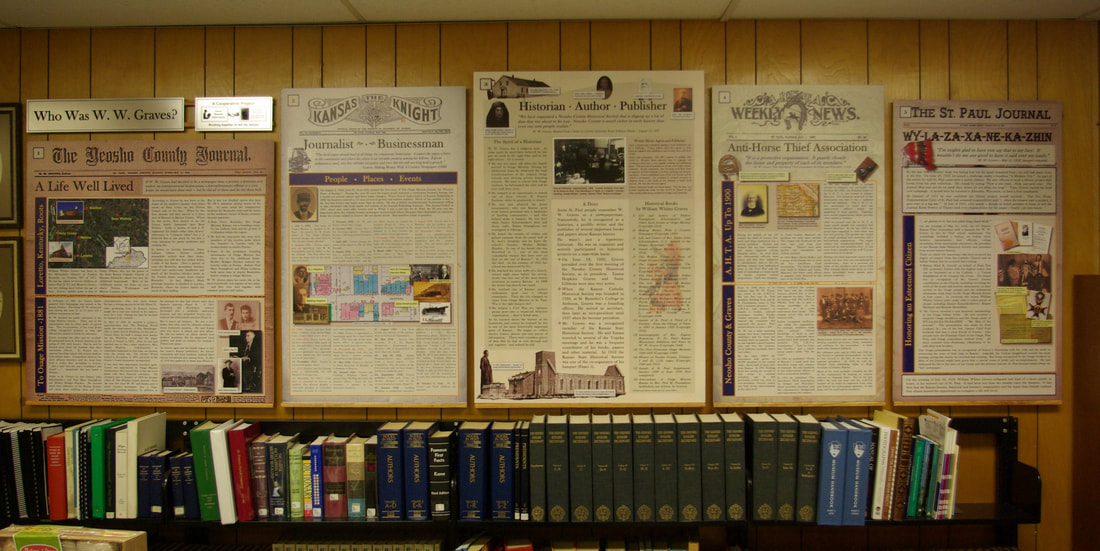|
In the early spring of 2013 the Board of Directors of the Graves Memorial Public Library, in St. Paul, took on an interesting project. Board president, Lon Smith knew that the memory of library founder, William Whites Graves had faded. He also knew that Graves was a pretty remarkable guy. Lon came up with the idea of celebrating Graves’ 142nd Birthday on October 26th of that year. But beyond ice cream and cake, Lon wanted to leave something more permanent in the library. After a little brainstorming, we came up with the idea of an interpretive display about the life and times of W.W. Graves. There was a good-sized section of wall, in the front part of the building that would work. I agreed to take on the research and display panel work. Lon and board member Jane Ann Beachner would provide checking, proofreading, and financial backing. This is a good time to mention that this was my first shot at creating a full-up interpretive display. In my previous life, I had done a lot of maintenance and litigation research. I also supervised a group of artists and publishing specialists who were a lot smarter than I was. Some of their expertise had rubbed off, but it turned into a bit of a challenge. Over the next few months, I dug through nearly 300 articles, photos, letters, and other items that described Graves’ life from childhood through his death in 1952. The more I dug, the more fascinating this man’s life became. My early impression of W. W. Graves was that of a very intelligent, competitive, and religious young man with a solid work ethic. He had a strong and defining sense of morality, justice, ethics, and politics, both personal and public. He connected himself with the right people early on, and then let his personal attributes carry him through an exceptional life. One thing was very clear. His early exposure to the Jesuit missionaries who founded the Catholic Mission, and the town of Osage Mission was a driving force during his adulthood. As I pulled information together, I decided that individual display panels would cover five aspects of Mr. Graves’ life:
Then I turned to the task of laying out the display panels, which turned out to be fairly easy. By the time I collected the research material, I also had uncovered many, many photos, maps, illustrations, and other material that just had to be assembled into graphical format. I might add that a very large part of Graves's information came from a cousin who had donated two boxes of material to the local museum about a year before I started the project [1]. Also, with Graves having been the editor of several newspapers and a magazine, I decided to use the front pages of those papers as backgrounds for four of the panels. [2]  Finished display panels in Graves Memorial Public Library, St. Paul. Finished display panels in Graves Memorial Public Library, St. Paul. As I laid out panels, my wife, Rosie worked with me and offered suggestions and corrections. Then, library board member, Jane Ann Beachner, received semi-finished panel artwork and was my final editor. These two ladies caught a lot of my errors and made the display product much better. In the end, I learned (re-learned) a lot of proper punctuation from Jane Ann. In Mid-August I turned the panel art over to the Pitt State Graphics Department and our friend Larry Jump converted computer files into a set of five panels and some metallic introduction plates. Rosie and I built a set of simple mounting frames and in a matter of a few hours, one early September afternoon, the display became reality. With the project finished, we only had one more thing to do before the October birthday party. Rosie and I loaded our camper and made a 600-mile trip east. After spending six months getting very acquainted with St. Paul’s ‘Most Esteemed and Honored Citizen,’ [3] we wanted to visit the Holy Land of west-central Kentucky where his life began. We met Leo and Marie Schettler at a campground near Bardstown and spent several days roaming the area around Manton, Bardstown, Loretto, and Nerinx. We strongly recommend that trip for anyone whose family originated here in Osage Mission – St. Paul in the late 19th century. Those old central Kentucky Catholic church cemeteries contain a lot of very familiar names. Even if your family doesn't have Kentucky roots, you will likely find it interesting. Oh — by the way! You also will be in the heart of Kentucky Bourbon Country. The Maker's Mark Distillery is at Loretto, Kentucky.  Click above to download a copy of the research document described above. Click above to download a copy of the research document described above. If you would like to get more familiar with W.W. Graves, and his eastern Kentucky roots, click on the cover page illustration here to open a copy of our research document. It is a 6MB PDF file and might take a moment to download. As noted above, the document was laid out to develop the storylines for the five display panels. Chapter 1 is an overview of Mr. Graves' life. The four remaining chapters expand on the important aspects of his life. You should expect some repetition among chapters. Some Reference and Background Information:
1. In 2012 St. Paul native Karen Hopkins Steinbacher donated two boxes of Graves-Hopkins material to the local museum. The boxes proved to be a treasure chest of family and local information. W.W. Graves was Karen’s uncle. In early 2014 I sorted through the boxes and cataloged the contents into the Graves-Hopkins Collection that is in the museum research room. 2. Graves was the publisher of the Neosho County Journal and St. Paul Journal (same newspaper, different names). He also published the Anti-Horse Thief Association weekly and the Kansas Knights of Columbus Magazine (Kansas Knight). 3. The phrase “Most Esteemed and Honored Citizen” was the headline of the July 24, 1952, issue of the St. Paul Journal that contained Mr. Graves’ front-page obituary. Click the upper page, below to open the entire page in a separate window or tab. Comments are closed.
|
Thoughts 'n ThingsSome 'Thoughts' and short articles about past and present-day St. Paul and the Southern Kansas - 4 State Region. Archives
December 2023
Categories
All
|
- Home
-
Our Story
- 1. The Stage is Set
- 2. The Osages Enter Kansas.
- 3. Earliest Commerce
- 4. Earliest Protestant Missions
- 5. The Catholic Osage Mission >
- 6. Progress and Tragedy
- 7. The Missionary Trails >
- 8. A Dangerous Balance - The Civil War >
- 9. The Osage Leave Kansas >
- 10. A Very Unique Community is Born >
- 11. Regional Boarding Schools >
- 12. Transitions
- 13. The Passionists Era Begins
- 14. Citizen Lawmen - The A.H.T.A. >
- 15. The Passionist Influence is Expanded
- 16. The Schools Today >
-
Characters
- The Osages
-
The Missionaries
>
- Father John Schoenmakers >
- Fr. John Bax >
- Mother Bridget Hayden
-
Fr. Paul Ponziglione
>
-
Father Paul's Memoir
>
-
Index - Father Paul's Memoir
>
- Dedication & Introduction
- IX. Construction & Acceptance of Mission Buildings.
- X. Fr. Schoenmakers Arrives at Osage Mission
- XI. Miss Lucille St. Pierre Came to the Neosho
- XII. Progress of the Schools
- XIII. Origin and Development of the Roman Catholic Church in Kansas
- XXVII - Winds of War
- XXVIII — Fr. Schoenmakers Return
- Chapter XLII - Farming Issues, Death Of Father Colleton
- Chapter XLIX - Includes The Death of Fr. Schoenmakers
- Chapter L — Dedication of the New Church
- Conclusion
- Appendix I — Copy of a letter to Sister M. Coaina Mongrain about the coming of the Sisters of Loretto at Osage Mission
- Appendix 6 — A Sketch of my Biography
- Appendix 7 - Letter to W. W. Graves
-
Index - Father Paul's Memoir
>
-
Father Paul's Memoir
>
- Father Philip Colleton
- Brother John Sheehan
- W. W. Graves
- 17 Sisters
- 17 Sisters II - Fr. Fox's Sermon
-
Who's Behind the Window
>
- Who We Were 120 Years Ago
- 1. The Thomas Carroll Window
- 2. The W.W. O'Bryan Window
- 3. The Jas. Owens & Family Window
- 4. The C.P & C.J. Hentzen Windows
- 5. The Dr. McNamara & Family Window
- 6. The Fitzsimmons & Family Window
- 7. The Parents of T.K. Joyce Window
- 8. J.E. Sevart & Family Window
- 9. The Rev. John Schoenmakers S.J. Window
- 10. The Patrick Diskin and L&M George Window
- 11. The J.A. Johnston & Family Window
- 12. The Peter & Jacob Bonifas Windows
- 13. The Mr & Mrs. Patrick Keeting Window
- 14. The John Butler Window
- 15. The Mr. & Mrs. Gutting Window
- 16. Rosette Window Above Doors
- 17. The Michael A. Barnes Window
- 18. The Henry M. O'Bryan Window
- 19. The John and Bridget McCarthy Window
- The Sodality Windows
- The Church Women's Bonfire (Graves)
- Beechwood
- John and Margaret Naudier
- Fr. Tom McKernan - The Poet Priest of Kansas
- The Dimond Family and Estate Sale
- Dear Sister >
- A Year and a Day — Passionist Memories.
- Mary Elizabeth Lease
- K of C Council 760 - The Early Days
- Our Hometown Boys
- SPHS Class of 1956
-
Places
- The Great American Desert
- St. Francis Catholic Church
- St. Francis de Heironymo Catholic Church Grounds
- St. Paul - 135 Years Ago
- St. Paul - 1890's as a Scale Model.
- St. Paul - The Booming 60's
- Osage Mission as a Statewide History Finalist
- St. Francis Cemetery
- Hope Cemetery
- The Basement Chapel
- World War I Museum Display
- St. Paul Middle School >
- Ladore
- St. Boniface, Scipio KS
- Road Trip - Father Emil Kapaun
- Exchange State Bank Robbery!
- Thoughts ...
- Links
- Link Page
Thoughts 'n Things
Past and Present Day St. Paul, Southern Kansas and The Four - State Region.

|
acatholicmission.org is a privately hosted website. We hope that our site will educate and entertain those who are interested in the fascinating Osage Mission - St. Paul - Neosho County Kansas story. Ours is a regional story that crosses state lines, ethnic groups, faiths and a variety of frontier and post-frontier interests. Enjoy.
acatholicmission.org Copyright © 2016 - 2024. All rights reserved. (See copyright note on Contact page.) |


 RSS Feed
RSS Feed